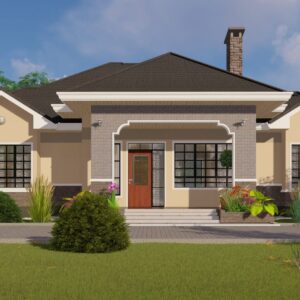After a busy period working on various architectural projects, we’re excited to share insights into the cost of hiring an architect in Kenya. The construction industry here is experiencing steady growth following the slower decades of the ’80s and ’90s. With the expanding economy, there is a surge in demand for residential and commercial spaces. While many new buildings are being constructed, not all meet the desired standards of functionality or aesthetics.
Understanding the Cost of Hiring an Architect in Kenya for Full Project Design
The building process in Kenya has evolved significantly over the years, with modern construction techniques focusing on functionality, cost-effectiveness, aesthetics, energy efficiency, comfort, and sustainable land use. However, many Kenyan builders may not achieve these standards due to budget constraints, leading to issues in construction quality and design.
Clients often attempt to hire architects at reduced rates to save on project costs. The Architects and Quantity Surveyors Act (Cap 525) defines the recommended fees for architects and quantity surveyors, detailing the services they provide throughout a project. Understanding these services and their associated costs helps clients work more effectively with their building consultants to achieve their goals.
The Role of Architects in Long-Term Projects
Building a project involves numerous stages, each requiring careful planning and execution. From initial site studies and conceptual design to detailed planning and documentation, an architect’s work spans several months or even years. For a project to be successful, all these stages must be carefully managed and coordinated. Typically, a building project can take anywhere from 18 months to 2 years to complete.
Architects in Kenya collaborate with other professionals, such as quantity surveyors, electrical and mechanical engineers, and structural engineers, to ensure that every aspect of the project is harmonized before construction begins. Their primary role is to manage the project and ensure that all documentation is thorough and of high quality. It’s crucial for clients to recognize the importance of these initial steps in ensuring the overall success of the project.
What Do Kenyan Architects Charge?
To ensure high-quality work, clients must compensate architects fairly for their services. The Architects and Quantity Surveyors Act outlines a fee structure based on the different stages of a construction project:
1. Project Initiation and Basic Design: This phase involves developing initial sketches to give the client an idea of the building’s size, functionality, appearance, and placement. This stage typically accounts for about 15% of the architect’s total fee.
2. Preliminary Detailed Design: At this stage, more detailed but not yet final drawings are created for obtaining necessary approvals. These plans can be used for basic construction but may lack finer details that need to be worked out later. This stage represents about 25% of the total fee.
3. Comprehensive Design: This phase involves creating highly detailed drawings that cover all aspects of the building’s construction, including specifics such as window and door designs, and finishes for rooms like kitchens and bathrooms. Due to the complexity and detail required, this stage accounts for about 35% of the total fee.
4. Contract Administration and Construction Supervision: In this final stage, a contractor is selected, contracts are drawn up, and the architect oversees the construction process to ensure that the project is completed as designed. This stage represents the remaining 25% of the total fee.
The law stipulates that a Kenyan architect must charge a minimum of 6% of the total construction cost for these services. For renovations or alterations of existing buildings, the fee is higher at 10% of the total cost. This fee structure is consistent across all East African states.
Time-Based Fees for Specific Projects
In some cases, particularly for government or international projects, architects may work on a time-based fee structure. This involves estimating the time required for the project and charging a fixed rate per hour, day, or month. This approach is often used when the exact cost of construction is difficult to estimate or when an architect is hired as a consultant for a specific aspect of a project.
The Importance of Hiring a Qualified Architect in Kenya
Engaging a skilled Kenyan architect is crucial for ensuring a well-designed building. The cost of building materials remains the same, whether the building is poorly designed or thoughtfully executed. However, a well-designed building will have a higher market value and attract more buyers or tenants, whereas a poorly designed building might struggle to find interest or command a lower price.
If you are planning a building project, consider working with an experienced Kenyan architect to maximize your investment and ensure the success of your project. If you’ve recently completed a project, did you work with a qualified architect? How did it impact the outcome of your project?
For every design, we do;
1. Architectural Drawings
2. Structural Drawings
3. MEP Drawings( Mechanical drawings, Electrical drawings and Plumbing drawings)






[…] Related post: How Much Does It Cost to Hire An Architect in Kenya For Your Entire Project Design? […]
[…] Related Post: How Much Does It Cost to Hire An Architect in Kenya For Your Entire Project Design? […]
[…] Related post: How Much Does It Cost to Hire An Architect in Kenya For Your Entire Project Design? […]
[…] Related post: How Much Does It Cost to Hire An Architect in Kenya For Your Entire Project Design? […]
[…] How Much Does It Cost to Hire An Architect in Kenya For Your Entire Project Design? […]
[…] How Much Does It Cost to Hire An Architect in Kenya For Your Entire Project Design? […]
[…] How Much Does It Cost to Hire An Architect in Kenya For Your Entire Project Design? […]
[…] How Much Does It Cost to Hire An Architect in Kenya For Your Entire Project Design? […]
[…] How Much Does It Cost to Hire An Architect in Kenya For Your Entire Project Design? […]
[…] How Much Does It Cost to Hire An Architect in Kenya For Your Entire Project Design? […]
[…] How Much Does It Cost to Hire An Architect in Kenya For Your Entire Project Design? […]
[…] How Much Does It Cost to Hire An Architect in Kenya For Your Entire Project Design? […]
[…] How Much Does It Cost to Hire An Architect in Kenya For Your Entire Project Design? […]